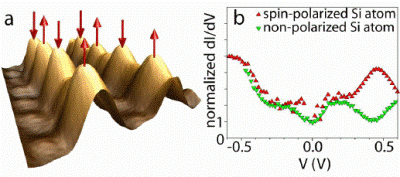Oct 18 2012
Nano-ribbons of silicon configured so the atoms resemble chicken wire could hold the key to ultrahigh density data storage and information processing systems of the future.
 (a) Three-dimensional representation of a topographic STM image taken at low temperature on the gold-stabilized vicinal Si(553) surface. Two step edges are imaged. The large bright features are at the locations of the spin-polarized silicon step-edge atoms, as indicated by the red arrows. (b) Normalized conductance curves measured by STM at polarized and non-polarized Si step-edge atoms, revealing the predicted spin-polarized state near 0.5 V.
(a) Three-dimensional representation of a topographic STM image taken at low temperature on the gold-stabilized vicinal Si(553) surface. Two step edges are imaged. The large bright features are at the locations of the spin-polarized silicon step-edge atoms, as indicated by the red arrows. (b) Normalized conductance curves measured by STM at polarized and non-polarized Si step-edge atoms, revealing the predicted spin-polarized state near 0.5 V.
This was a key finding of a team of scientists led by Paul Snijders of the Department of Energy’s Oak Ridge National Laboratory. The researchers used scanning tunneling microscopy and spectroscopy to validate first principle calculations – or models – that for years had predicted this outcome. The discovery, detailed in New Journal of Physics, validates this theory and could move scientists closer to their long-term goal of cost-effectively creating magnetism in non-magnetic materials.
“While scientists have spent a lot of time studying silicon because it is the workhorse for current information technologies, for the first time we were able to clearly establish that the edges of nano-ribbons feature magnetic silicon atoms,” said Snijders, a member of the Materials Science and Technology Division.
The surprise is that while bulk silicon is non-magnetic, the edges of nano-ribbons of this material are magnetic. Snijders and colleagues at ORNL, Argonne National Laboratory, the University of Wisconsin and Naval Research Laboratory showed that the electron spins are ordered anti-ferromagnetically, which means they point up and down alternatingly. Configured this way, the up and down spin-polarized atoms serve as effective substitutes for conventional zeros and ones common to electron, or charge, current.
“By exploiting the electron spins arising from intrinsic broken bonds at gold-stabilized silicon surfaces, we were able to replace conventional electronically charged zeros and ones with spins pointing up and down,” Snijders said.
This discovery provides a new avenue to study low-dimensional magnetism, the researchers noted. Most importantly, such stepped silicon-gold surfaces provide an atomically precise template for single-spin devices at the ultimate limit of high-density data storage and processing.
“In the quest for smaller and less expensive magnets, electro-motors, electronics and storage devices, creating magnetism in otherwise non-magnetic materials could have far-reaching implications,” Snijders said.